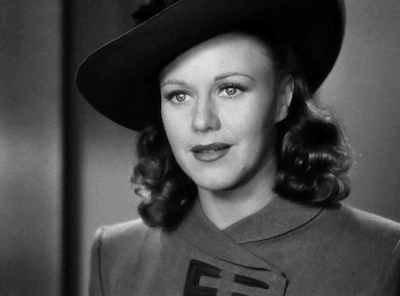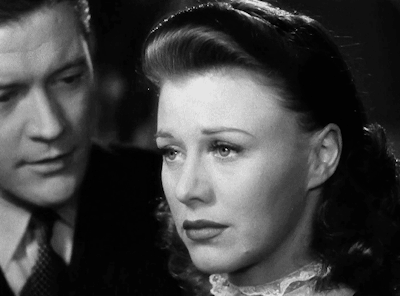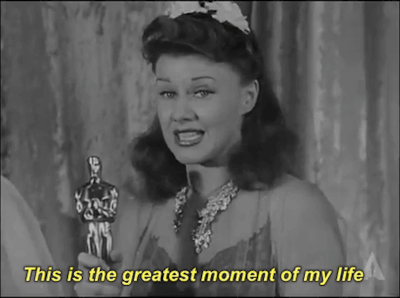How KITTY FOYLE Changed Ginger Rogers's Life
Let’s talk about one of my favourite Oscar-winning performances
today, in honour of Ginger Rogers’s 113th birthday today: her Best
Actress-winning performance in Kitty Foyle.
Kitty Foyle was a bestselling novel by
Christopher Morley, first published in 1939. It tells the story of the
eponymous heroine, a working class white collar girl from Philadelphia who
falls in love with a socialite and clashes with his family.
It was an immediate bestseller, and RKO paid $50,000 for the
film rights to the story. An RKO producer by the name of David Hempstead immediately
flagged it as a property for Ginger Rogers, which was something of an unusual
choice: Ginger had never done straight drama before.
Ginger, at that point in her career, had spent a decade making
mostly musicals and romantic comedies for RKO. Let’s not downplay her repertoire,
though. That decade included nine successful musicals with Fred Astaire; as well
as three of my favourites, Vivacious Lady, Bachelor Mother and Fifth
Avenue Girl.
In her autobiography, Ginger, My Story, she wrote that
she wanted to extend her range into more dramatic fare but that the front
office at RKO never bothered to learn more about her since she was minting them
money with Fred Astaire.
It wasn’t until David Hempstead sent her a copy of Kitty
Foyle with the note that the character would be perfect for her that she realized
someone else saw what she was capable of.
The only problem was that Ginger read the book and thought it
was too graphic. “There were explicit love scenes in it that were quite
disturbing to me,” she wrote. “As I read these passages, I found myself
passing judgement on them. ‘That could never pass the censor board. So what
good is it for me to spend time reading it?’”
It wasn’t just that she was a little conservative
reading what she did—she was straight up offended that RKO and Hempstead
would even consider her for the role. The only reason she didn’t call
him up and lambast him for the slight was that he’d already left the studio for
the day.
But cooler heads prevailed in the form of Lela Rogers, who
reminded Ginger, after speed-reading the book, that the studio would have to do
a total rewrite before they could make the movie, and “Then, maybe you’ll
want to do it.”
Ginger followed her mother’s advice, and when she finally
spoke to Hempstead, she was calm. She told him her concerns. He replied: “Ginger,
for heaven’s sake, don’t tell anyone at the studio you disliked it. I’m having
it rewritten and when that’s done, I’ll submit it to you again. If you want to
turn it down then, okay, but remember, RKO bought this book as a starring vehicle,
expressly for you. SO DON’T TURN IT DOW until you have read the rewrites.”
She got a copy of the rewrites just over a month later and was
urged to read it immediately—others were sniffing around it, and Hempstead
needed to know as soon as possible if she wanted to make it. The script had
been rewritten by Dalton Trumbo and Donald Ogden Stewart, writers of immense
calibre.
“For the next two hours I sat reading, laughing,
and crying. I realized it was one hell of a script, and was convinced that
whoever played the role would end up with an Oscar. I saw it that vividly.
(Sorry, Olivia [de Havilland], you didn’t get this one!)”
Side note: the ‘rivalry’ between Ginger and Olivia over film
roles is something else to explore in a different post. Ginger turned down both
To Each His Own and The Snake Pit, which garnered Olivia an
Oscar win and an Oscar nomination, respectively.
Back to Kitty Foyle: Ginger wanted to make the movie so
badly that she skipped a planned vacation in order to make it. And she took
command of the role as soon as filming began. She determined that her hair
needed to be darker, not blonde, as the daughter of an Irishman. She also felt
like she could collaborate with director Sam Wood, and made character
suggestions throughout filming.
Of the role, Ginger wrote, “In Kitty Foyle I had an
opportunity to create a three-dimensional portrait of a young American woman,
and when the picture was finished, I felt I’d met the challenge.”
Kitty Foyle and Ginger Rogers became
very popular once the film was released in December 1940. It was the
highest-grossing RKO film that year, and one of the best-reviewed as well.
The character became a symbol of the everyday working woman
and Ginger’s career was boosted by a surprising performance—no more was she
just the dancing dame, now everyone knew she could carry a dramatic role.
Kitty Foyle’s influence was so wide-spread
it even touched upon fashion. The ‘Kitty Foyle’ dress was a dark-coloured
shirtwaist with white or light-coloured collar and cuffs, with short sleeves.
Ginger was one of the five actresses nominated for Best Actress
in 1940. Her competition couldn’t have been any stiffer: Katharine Hepburn, Bette
Davis, Joan Fontaine and Martha Scott. And none of them had phoned it in that
year.
Still, it might have been something of a shock for contemporary
audiences—and certainly for modern ones, who only remember Ginger as the one who
did ‘everything Fred Astaire did, just backwards and in high heels’—when Ginger’s
name was called. It definitely was for Ginger.
She wrote that she didn’t even hear her name called and
definitely didn’t prepare a speech, since she figured Bette or Katharine would
win again. “I really can’t accurately recall the words, but believe me, I was
deeply grateful for God’s love being with me at this momentous honour.”
Ginger was the film’s only win that night—Kitty Foyle had
been nominated for Best Picture, Best Director, Best Screenplay and Best Sound
Recording as well.
She held onto the praise that Kitty Foyle gave her, and
appreciated all of the warm words people sent. In her autobiography, she writes
that the most special of these letters was from Fred Astaire, who wrote: “Hello
Cutie—
“Saw 'Kitty' last night and must write this note
to say 'That's it!' Yes, yes, a thousand times yes! You were superb, Ginge--it
was such a solid performance--the kind one seldom sees on stage or screen and
it should bring you the highest honors anyone can win!!
“Hope to see you soon.
“As ever your, Fred.”
Ginger continued acting throughout the ‘40s, hit after hit after hit: Tom, Dick and Harry; The Major and the Minor (my personal favourite); Roxie Hart; Tales of Manhattan (a remake of Grand Hotel with Ginger in the Garbo role); and Tender Comrades, off the top of my head, showed her range and only strengthened her chops.





Comments
Post a Comment